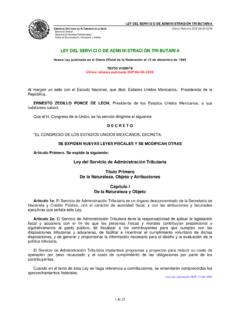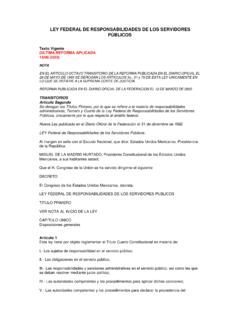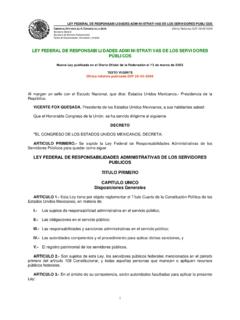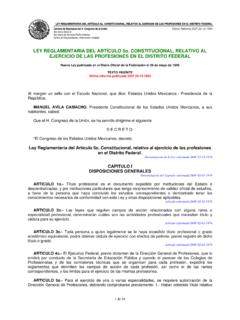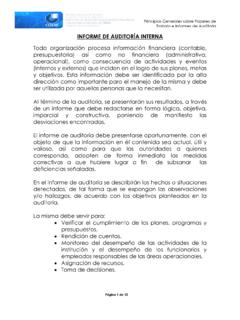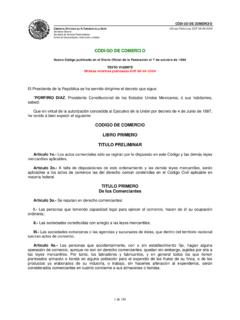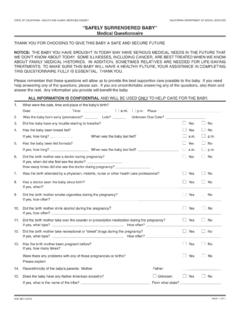Transcription of Fact Sheet: H.R. 4954: The SAFE Port Act - OAS
1 Fact Sheet: 4954: The safe Port Act Committee on Homeland Security Subcommittee on Economic Security, Infrastructure Protection, and Cybersecurity Dan Lungren (R-CA), Subcommittee Chairman House Homeland Security Subcommittee Chairman Dan Lungren (R-CA) and Rep. Jane Harman (D-CA) have introduced the Security and Accountability for Every ( safe ) Port Act. The safe . Port Act is a comprehensive proposal that will take steps to: prevent threats from reaching the United States, track and protect containers en route, and harden security at ports . I. Enhancing Security at ports In the aftermath of 9/11, the United States must continue to increase domestic port security and harden our critical infrastructure defenses.
2 Recognizing that we must be aggressive in protecting ports , the bill: Requires the Department of Homeland Security (DHS) Secretary to complete a timeline for deployment of nuclear and radiological detection systems at all seaports, and to establish standard operating procedures for examining containers;. Provides risk-based funding through a dedicated Port Security Grant Program to harden ports against terrorist attacks and enhance capabilities to respond to attacks and resume operations;. Sets deadlines for DHS implementation of the Transportation Worker Information Credential (TWIC) program; in the interim, requires DHS to conduct terrorist watch-list checks of all port employees with access to secure areas within 90 days of enactment.
3 Requires the Secretary to enhance port security coordination between federal, state, local, and private sectors partners by establishing an integrated network of virtual and physical command centers;. Requires the Secretary to develop protocols for resuming trade after a transportation security incident through planning, improved government and private sector coordination, and prioritization of vessels; and Ensures that employees operating radiation portal monitors are protected from any harmful effects of using radiation detection equipment. II. Preventing Threats from Reaching the United States It is essential that our nation take a global approach to the way we thwart terrorist attacks and protect ports .
4 Recognizing that we must be strategic in preventing threats from ever reaching the United States, the bill: Requires DHS to conduct security assessments for foreign ports interested in participating in the Container Security Initiative (CSI) program, an initiative designed to enable DHS to examine high- risk maritime cargo at foreign seaports;. As part of CSI, authorizes the Secretary of DHS to loan detection equipment and provide training to host nations to effectively examine containers bound for the United States. Strengthens the Customs-Trade Partnership Against Terrorism (C-TPAT) program, which creates partnerships between DHS and the private sector to establish transparency in the supply chain, enhance security measures, and encourage greater information sharing.
5 Sets minimum standards for C-TPAT participation and divides program membership into tiered categories, based on the level of each country's security cooperation;. Establishes a top tier for the most trusted private sector partners participating in the C-TPAT. program, which will provide additional processing benefits in exchange for greater security cooperation; and III. Tracking and Protecting Containers En Route to the United States The ability to efficiently track potentially high-risk containers that are traveling to the United States is imperative to protecting American ports . In an effort to detect and protect containers en route to the United States, the bill: Improves the Automated Targeting System (ATS), which is designed to identify high risk containers before they reach American soil, by determining additional commercial data elements necessary for more robust targeting.
6 In addition to manifest data, requires DHS to collect additional cargo data from shippers receiving material through ports ;. Improves the International Trade Data System, which links all Federal commercial data to ensure more thorough security checks while providing the private sector with a single system to submit required information;. Requires the Secretary to establish standards for securing containers within 180 days;. Revives Operation safe Commerce, which is designed to improve utilization of private sector initiatives, boost research and development activities, and enhance coordination within DHS; and Directs the Department to conduct additional research and testing on technology integration, access control, and data sharing capabilities for port security.
7 For more information, please contact the House Committee on Homeland Security Press Office (202-226-9600) or visit ###.

